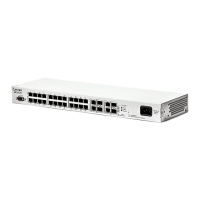10 MES1000, MES2000 Ethernet Switches
2 PRODUCT DESCRIPTION
2.1 Purpose
MES1000 and MES2000 series devices are the managed stackable network switches that operate on
data-link and network layers of the OSI model.
MES1024 network switches are equipped with 24 Fast Ethernet ports with electric interfaces and 2
Gigabit Ethernet ports combined with slots for SFT transceiver installation (combo ports).
MES1124, MES1124M, MES1124MB network switches are equipped with 24 Fast Ethernet ports
with electric interfaces and 4 Gigabit Ethernet ports combined with slots for SFT transceiver installation
(combo ports). MES1124MB allows operation from 12V battery as a backup power source.
MES2124, MES2124M network switches are equipped with 24 Gigabit Ethernet ports with electric
interfaces and 4 Gigabit Ethernet ports combined with slots for SFT transceiver installation (combo ports).
MES2124MB network switches are equipped with 24 Gigabit Ethernet ports with electric interfaces
and 4 Gigabit Ethernet ports combined with slots for SFT transceiver installation (combo ports). Device
allows operation from 12V battery as a backup power source.
MES2124P network switches are equipped with 24 Gigabit Ethernet ports with electric interfaces
and PoE+ support and 4 Gigabit Ethernet ports combined with slots for SFT transceiver installation (combo
ports).
MES2208P network switches are equipped with 4 electric ports Gigabit Ethernet with PoE+ support,
4 Gigabit Ethernet ports combined with slots for SFT transceiver installation (combo ports), 2 Gigabit
Ethernet optical ports and 2 Gigabit Ethernet electric ports.
A blocking, that appears when device output ports are overloaded with traffic
coming from highly active sources. It may lead to traffic loss from other low
activity sources. The switch resource reservation methods are used to prevent
such situations. Not supported in the current firmware version.
The backpressure routing method is utilized in half-duplex connections for
management of data streams, coming from the opposite devices, by means of
collisions. This method allows to avoid buffer overruns and the loss of data.
Automatic cable type detection—crossed or straight.
– MDI (Media-Dependent Interface—straight)—cable standard for
connection of terminal devices
– MDIX (Media-Dependent Interface with Crossover—crossed)—cable
standard for connection of hubs and switches

